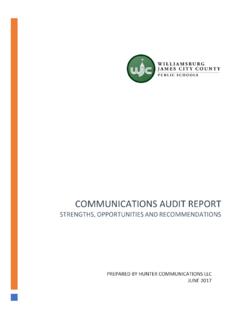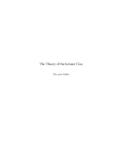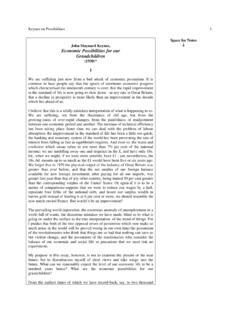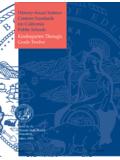Transcription of The 1920s: Lifestyles and Social Trends: Overview
1 The 1920s : Lifestyles and Social trends : Overview American Decades Ed. Judith S. Baughman, Victor Bondi, Richard Layman, Tandy McConnell, and Vincent Tompkins. Vol. 3: 1920-1929. Detroit: Gale, 2001. COPYRIGHT 1994-2001 Gale, COPYRIGHT 2005 Gale, COPYRIGHT 2007 Gale, Cengage Learning THE 1920s : Lifestyles AND Social trends : Overview "The Roaring Twenties." The 1920s have been dubbed everything from "The Roaring Twenties" and "The Era of Wonderful Nonsense" to "The Decade of the Dollar" and "The Period of the Psyche" to the "Dry Decade" and the age of "Alcohol and Al Capone.
2 " Many historians regard the years between world War I and the stock-market crash of 1929 as the culmination of a long process of Social change, which Frederick Lewis Allen described as a "revolution in manners and morals." The Wake of world War I The 1920s opened in the aftermath of world War I. The war's brutality and devastation in Europe culminated in euphoria at home over the armistice, followed by political controversy over the Treaty of Versailles. While President Woodrow Wilson helped end the war "over there," he claimed Americans did not "want to be coached and led" and as a result offered no organized plan to convert the economy from military mobilization to peace or to incorporate masses of returning veterans into society.
3 Conversion to Peacetime Economy In the absence of government planning, conversion to a peacetime economy was abrupt. Veterans poured into the job market and competed with the nine million workers, including many blacks and women, who had advanced because of the economic expansion caused by the war. As government contracts terminated, construction companies planned new buildings and homes, and factories geared up to fill orders for domestic goods. The result was an inflationary boom in 1919, driving up prices and causing massive labor unrest.
4 Food prices rose 84 percent, clothing 114 percent, and furniture 125 percent. Mass-production workers responded with the first general strike in American history. Strikes of 1919 In the summer and fall of 1919, four million laborers from East Coast textile workers to nearly all the workforce in Seattle to Chicago's steelworkers and meatpackers went on strike. These strikes resulted, in large part, from wartime ideology and fears of postwar retrenchment: workers sought to bring America's wartime campaign for democracy in Europe back home to their factories and polling places and to protect their wartime jobs and wages.
5 By the early 1920s this enthusiastic campaign for workers' rights met with almost total defeat. Workers were unable to hold on to their wartime gains or establish collective bargaining agreements. Labor's Defeat Labor failed in the 1919 strikes for a variety of reasons. Isolation, ethnic divisions, and internal political conflicts within the labor movement fragmented what should have been unified efforts and thus under-mined workers' goals. Outside the labor movement, the Red Scare American political fears of Bolshevism and Communism in general after the Russian Revolution of 1917 mobilized forces against organized workers and the entire American Left.
6 Striking workers were defeated by Red Scare terror tactics, combative responses from employers, and fragmentation within their own ranks. The Red Scare The 1920s thus opened in a mood of fear and intolerance that would linger through the decade. The Red Scare led to bizarre, hysterical attacks against aliens and alleged Communists. Organizations such as the American Defense Society, the National Security League, and the American Legion led the offensive against radicals and foreigners. Foreign workers from Seattle were sent to Ellis Island for deportation, Socialist leader Eugene V.
7 Debs was imprisoned, and in a policy of "Ship or Shoot," Attorney General A. Mitchell Palmer rounded up 249 aliens in December 1919 to be deported on the ship Buford, dubbed the "Soviet Ark." In early 1920 thirty-two states passed politically restrictive laws and required teacher loyalty oaths. By the end of 1920 it was clear that no Communist revolution was spreading in Europe or at home, and most of the hysteria was over. A Revolution in Manners and Morals A series of profound changes in American life were in place and sharply felt by the 1920s .
8 As novelist Willa Cather commented, "The world broke into two in 1922 or thereabouts." first , between 1880 and world War I, the overall birth rate fell, and the divorce rate increased. In addition, rates of sexual activity both before and outside marriage increased. Finally, greater numbers of working - class women worked outside the home in factories, stores, and offices, and growing numbers of middle- class women attended college and entered professional careers. Grasping these transformations, moralists and Social critics feared by the 1920s that the American family was in crisis, and many wondered whether the institution was suited to the new Social order at all.
9 Transformations Broad patterns of economic and demographic change shaped this transformation in personal behavior. The economy shifted from the industrial model of the nineteenth century to a complex, bureaucratic system shaped by increasingly important corporations. Large-scale corporate capitalism brought prosperity to most of American society in the 1920s . But more laborers now worked for large, impersonal firms, and the new corporate order no longer valued restraint, thrift, and sobriety but instead was oriented toward conformity, consumerism, and individual gratification.
10 In addition, the arrival of large numbers of immigrants from southern and eastern Europe, as well as Asia, and the migration of blacks from the rural South to northern cities diversified mainstream culture. As white middle- class Americans learned dance steps that originated with blacks in Harlem and immigrants mixed with the native-born in urban dance halls and speakeasies, norms that guided the behavior of white middle- class Americans were slowly but permanently transformed. "Coolidge Prosperity." This new behavior occurred in the context of the widespread prosperity of the decade.





![Orwell, George - Nineteen eighty-four -biling e [pdf]](/cache/preview/2/b/0/d/7/8/d/c/thumb-2b0d78dca21260227afc7af6070de8fc.jpg)







